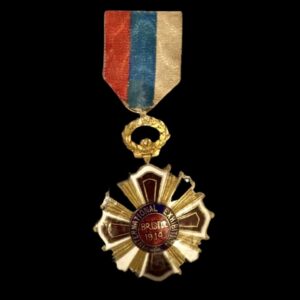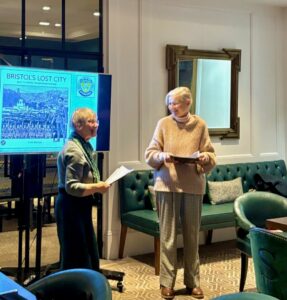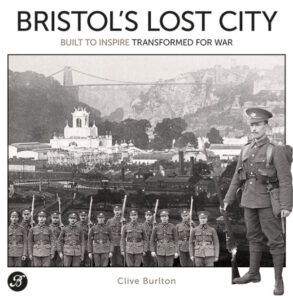Welcome Sharon: Before our Speaker Meeting we were delighted to welcome Sharon. We know she will enjoy our programme work and will settle in quickly
Clive started by telling us that that the following story came about because of a photograph he found of his grandfather in the first world war.
He then told us that in 1914 a large area between Ashton Gate and Cumberland Basin was developed to house the Bristol International Exhibition. They planned a trade fair and amusement park supported by the great and the good of Bristol. 200 workmen a week worked for just 10 weeks and then it opened. He showed us many pictures of the site as it developed, and it was nicknamed “White City”. It was an amazing site, that could be viewed from Bedminster Down. The funds £100,000 were only in place 3 days before it opened on 28th May 1914 and on the first day it welcomed 40,000 visitors. It had its own post office and also sold souvenirs one of which Clive passed round. He told the story of how he came by an enamel “badge” which he bid for on eBay but unfortunately, he was not successful. However, he met the person who did get it, who then gifted it to him on the understanding that whenever he gave his talk, he would pass it round which of course he did.
which he bid for on eBay but unfortunately, he was not successful. However, he met the person who did get it, who then gifted it to him on the understanding that whenever he gave his talk, he would pass it round which of course he did.
The main entrance to the project was in Ashton Avenue. There was no electric power, and so cables were brought from Feeder Road and at night the whole site was lit up. There were roller-coaster rides, daily pageants in addition to lions. After eight weeks the initial capital of £100,000 was spent, they struggled on until August 1914 when Britain declared war on Germany, and it closed on 15th August, the project was insolvent before it began.
Then the War Office requisitioned the site and took over the leases and the land. Lord Kitchener called for volunteers and the exhibition building then housed the new army nicknamed “Bristol’s Own”. Sadly 500 were lost at the battle of the Somme. By 1930 there was nothing left of the barracks, but it was used as a prisoner of war camp from 1944 to 1946. By the end of the Second World War there were 20,000 people on the housing list, and some went to live in the ”White City” on a temporary basis. Finally, the White City Allotments developed where service men worked, and these are the only surviving link to the story. Of course, Clive’s Grandfather survived the war, had he not, Clive would not have been here today!
So now every time we look across Bedminster Down towards the Suspension Bridge we will think of the “White City” and view it in a very different light. Thank you, Clive, for an amazing story from “peace to war”.



